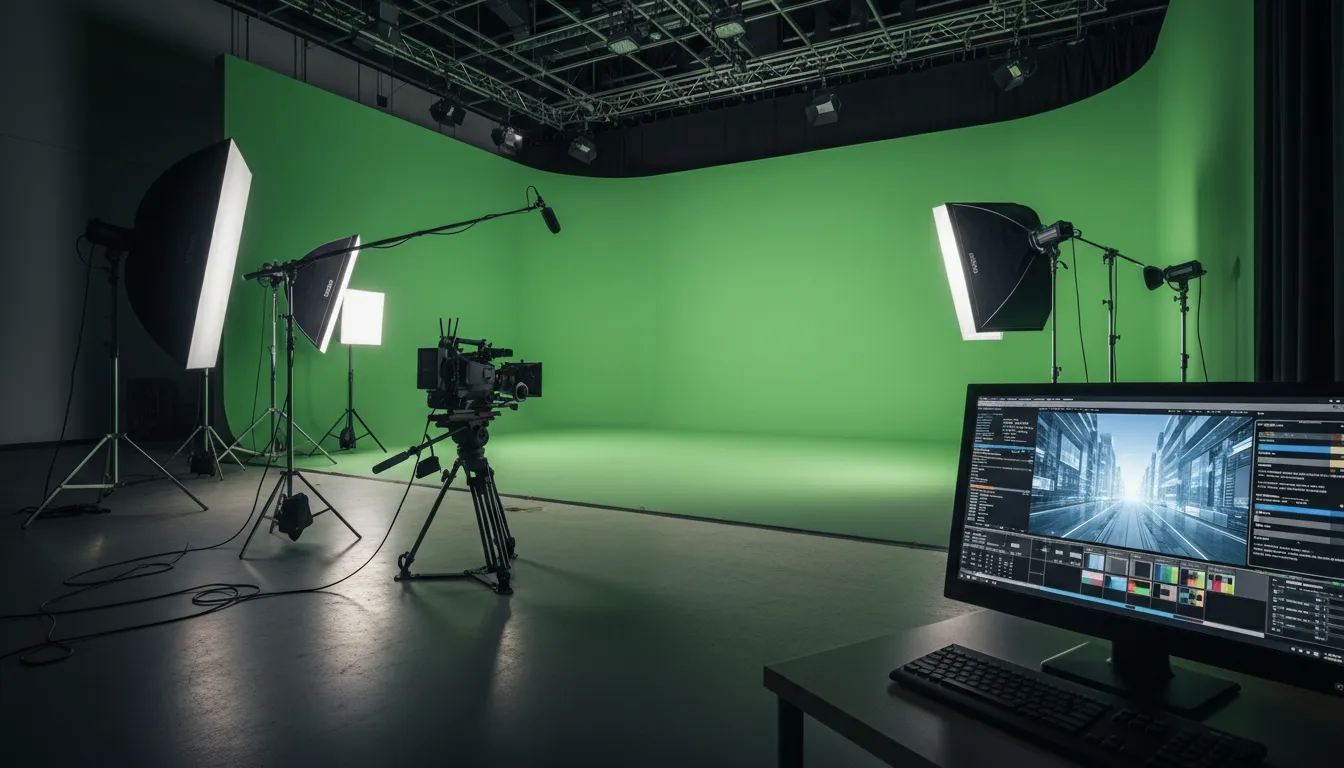Filmmaking is a sophisticated art form that combines technical proficiency, inventiveness, and storytelling. Whether to utilize a green screen or shoot on location is one of the most important decisions you will have to make as a filmmaker. The choice between Green Screen vs On-Location Filming affects not only the visual impact of your movie but also your budget and production process.
Understanding the differences between these two approaches will help you select the ideal shooting style for your project. This guide will break down the key points of Green Screen vs On-Location Filming, enabling you to make an informed decision for your upcoming production.
Advantages and disadvantages of filming with green screen
By lowering the expense of travel and site permits, the green screen technique can help you save money so you can invest more in equipment or post-production effects. With a green screen, you can create fantastical or unattainable environments without being restricted by reality or location. Additionally, a studio’s controlled environment ensures consistent lighting and a predictable schedule free from unexpected disruptions or weather delays.
However, producing a flawless final result with green screen requires a skilled team; otherwise, composite shots may look artificial and distract the audience from the story. Actors may also struggle to interact naturally with fictional settings, potentially affecting the authenticity of their performance. The technical complexity, including perfect lighting, high-quality backdrops, and precise editing, can increase initial costs and slow production, making the learning curve of Green Screen vs On-Location Filming a consideration for inexperienced teams.
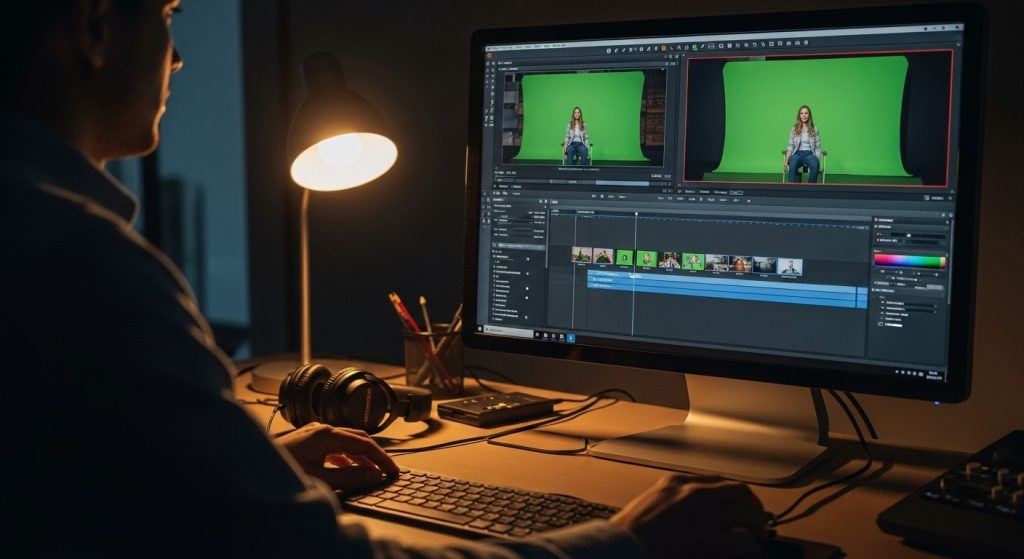
Advantages of Filming with a Green Screen
Green screen has several benefits. Filmmakers can achieve nearly anything on green screen as long as they put in the effort to make it perfect. The following are the main benefits of employing a green screen:
Explore Out with Visual Effects
Playing around with visual effects is crucial, since the finest part of filmmaking is being able to experiment with your graphics. There are different visual effects that may be achieved with green screens. These include the creation of aliens, explosions, and weather, as well as more routine jobs like item removal or backdrop replacement.
Different Backgrounds
If you don’t have an outside set but still want to film outside, all you need to do is install a green screen behind your actors and make up the rest in post-production. The same might be stated if it were snowing or pouring, and they couldn’t stay outside without getting wet or chilled.
Different space and location
One of the green screen’s biggest advantages is its adaptability. You can discover the ideal venue for your project because you can shoot anywhere. Adding a cityscape to your video will give it more authenticity and realism if you’re filming in an urban area. For natural filmmaking, you don’t need to locate mountains on a ridge or trees in a forest.
Creative Expression
The ability to have total control over your background is one of the biggest advantages of green screen filmmaking. It is therefore possible to have your players appear on a beach, in the mountains, or even in space.
You have lots of freedom!
Green screen filming has the advantage of being able to be done anywhere, at any time, and in any kind of weather. You get total autonomy. The greatest way to transfer your audience across the globe or into another dimension is to use a green screen. For instance, even if the place isn’t genuine, you may still generate a picture of a future urban or a lush tropical paradise. There are countless options.
What are the disadvantages of filming with green screens?
The usage of green screens is challenging and has some significant drawbacks. Among them are:
- Audiences will find the method unnatural and unsettling if the lighting is not correctly adjusted.
- Even if the method is less expensive than the real-world alternatives, it is nonetheless costly, time-consuming, and laborious, making it unsuitable for an independent or low-budget movie.
- During the keying process, any background color that is present in the foreground film will be replaced.
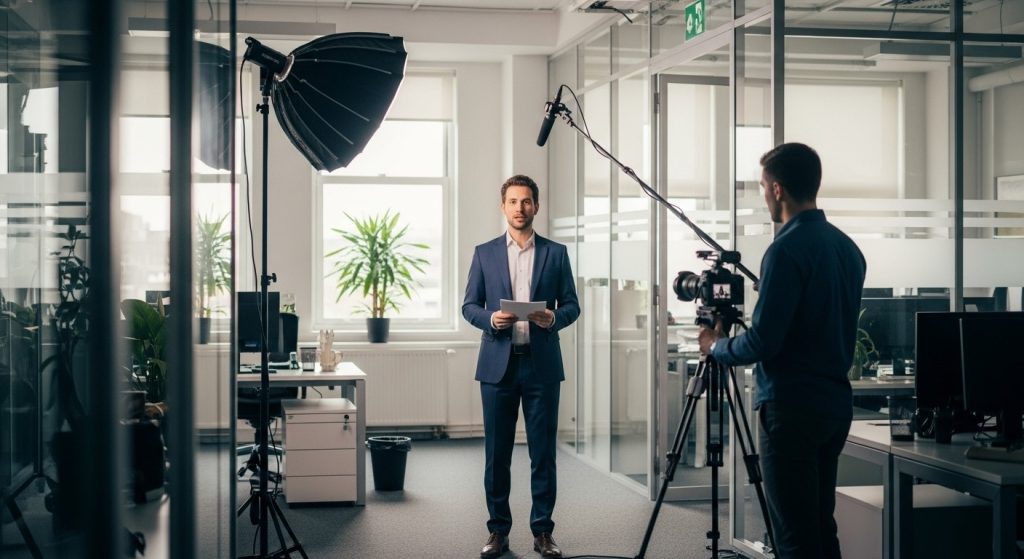
Advantages and Disadvantages of filming on location
Filming on location has lots of pros and cons, which we will discuss below:
Pros of filming on location
Advantages of filming on location
- Usually cost-saving: Particularly for straightforward or outside scenes, filming on an existing location may lower set construction expenses.
- Local Context & Culture: Locations can assist storytelling by providing cultural or geographic context (e.g., shooting in an actual market or beach village).
- Realism and Authenticity: Real-world settings offer authenticity, richness, and ambiance that are difficult to duplicate in a studio.
Disadvantages of filming on location
- Usually needs more investment!: Location shots can be more costly than studio ones due to travel, lodging, and crew insurance.
- Limited Control Over Setting: You have less creative control over lighting, camera movement, and props because you can’t alter the area as much as you can with a created set.
Can a green screen be created at home?
The actual process of building a green screen is really simple if you have the necessary supplies and space. To achieve proper chroma keying, you need to take into account a number of other factors:
- The background and foreground film must have the same lighting. The illusion will be ruined if the sun is strong in the backdrop and muted in the foreground, since the background and foreground will not blend together.
- The depth of focus in both foreground and background film should be the same; therefore, camera distance is also crucial.
- Additionally, cameras need to be steady and focused. The steadiness in the backdrop will be contrasted with a wobbly or vibrating video camera in the front. In a similar vein, zooming in or shifting focus will likewise contrast with the constancy of the background.
- A fine green screen scenario can be ruined by clothing, so make sure the performers’ clothes don’t match the color of the screen behind them. If they do, chroma keying will also change that portion of the garment.
- Both the foreground and background footage need to have uniform lighting. The illusion will be ruined if the sun is strong in the backdrop and muted in the foreground, since the background and foreground will not blend together.
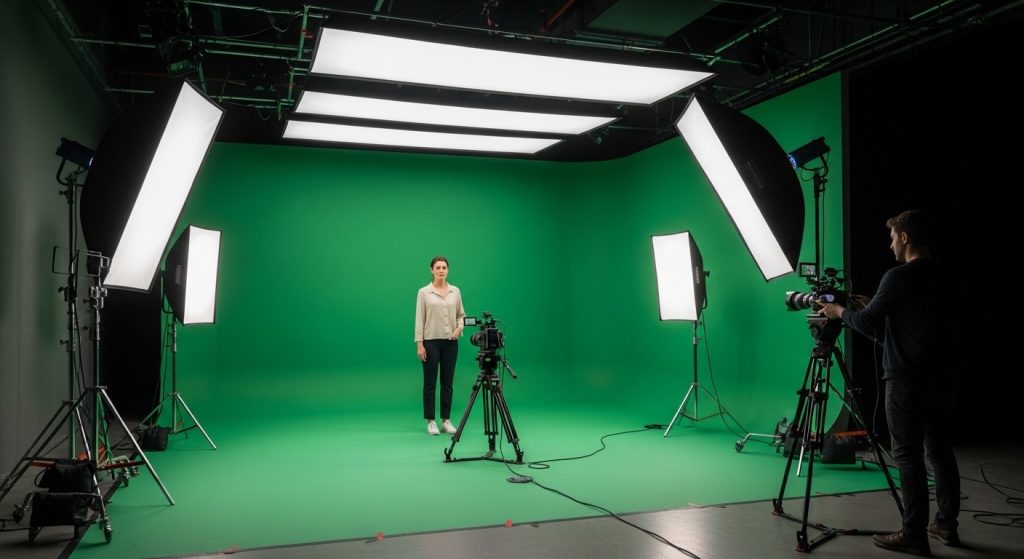
How to choose between Green Screen and a real location?
Where to film is one of the most important choices when organizing a video shoot, whether it’s for a commercial, interview, or social media content. Is it better to go on location and use a genuine place, or should you shoot on a green screen and digitally build the setting?
Your objectives, financial constraints, and level of control over the finished image will all influence the response. Let’s dissect it.
- Budget is one of the significant problems to discuss!
Cost is unquestionably a big consideration when filming a video. Money should ideally not be the determining factor when selecting whether to utilize a green screen, create a physical set, or choose a real location for your shot, but there are a number of other factors that may have a far more significant influence.
The ideal option is to shoot on location whenever feasible and wherever your plot permits in order to prevent a lot of unnecessary work during post-production. Of course, cost generally plays a significant role in the final decision.
- Of course, your goals are important too!
A real place will almost always seem and feel more credible if your brand message or story depends on authenticity. A window’s light, a wall’s texture, and background noise are examples of natural flaws that can emotionally connect with an audience.
However, a green screen allows you complete creative license when working on anything fantastical, futuristic, or visually impossible (such as cooking in a luminous dream kitchen or floating in space). You don’t have to leave the studio to put your subject.
- Technical control
A scene may be made or broken by lighting, shadows, and reflections. You have complete control in a studio with a green screen. It’s perfect for product photography, interviews, or situations where you require consistency over several days because every light and reflection can be carefully controlled. The illumination in a genuine place might vary minute by minute. It may offer exquisite realism or cause excruciating headaches.
Therefore, the green screen prevails when consistency is crucial (e.g., many reshoots or product close-ups).
- Think about everything!
The audience is more intelligent than before. Real settings nearly always work better if your campaign or content depends on trust and emotional storytelling, such as food companies, lifestyle scenes, or CSR initiatives. They can typically sense when something feels “fake.”
- Post-production Time
For green screen film to appear realistic, keying, compositing, and meticulous color matching are necessary. Filming on a real site might help you move more quickly if you have a tight production timeline.
Green Screen vs On-Location Filming?
Deciding between green screen and real-location filming is ultimately about choosing the visual environment that best communicates your message. Understanding the differences in Green Screen vs On-Location Filming helps you determine which method aligns with your production goals, audience, and desired tone.
Green screen offers complete control over lighting, branding, backgrounds, and visual effects, making it ideal for videos that require flexibility, consistency, or digital elements. On-location filming, by contrast, provides authenticity, emotional depth, and a real sense of place that is difficult to replicate in a studio. Choosing wisely between Green Screen vs On-Location Filming ensures your final product conveys the right atmosphere and visual impact.
Below, we outline when each option works best, supported by real-world business scenarios so different creators and organizations can quickly identify which approach fits their needs.
When to Choose Green Screen or Real Location
Choosing between green screen and real environments is not about which is superior—it’s about selecting the option that enhances your story, your brand, and your production requirements. Green Screen vs On-Location Filming comes into play here: green screen is ideal when you need controlled conditions, animated elements, or a uniform visual style, while real locations excel when atmosphere, context, and emotional resonance are crucial.
Here’s how different industries and content creators can determine the right approach:
Corporate & Business Videos
- Choose Green Screen: When you need clean, branded backgrounds for announcements, leadership messages, corporate updates, or videos that require inserting graphics, charts, or dynamic overlays.
- Choose Real Location: For culture-focused content—showing your office, teams, workspaces, daily operations, or behind-the-scenes moments—real environments build trust and visual credibility.
Explainer or Training Videos
- Choose Green Screen: Ideal for software tutorials, step-by-step explanations, instructional content, and employee training because it keeps the focus on the presenter and overlays.
- Choose Real Location: When the training requires demonstration in an actual environment—factories, medical labs, classrooms, workshops, or technical spaces.
Virtual Conferences & Webinars
- Choose Green Screen: Perfect for keynote recordings, professional intros, interviews, and content where consistent framing and digital branding matter.
- Choose Real Location: Use real spaces for event recaps, speaker meet-ups, panel discussions, or networking scenes that need the energy of a live environment.
Marketing, Advertising & Product Campaigns
- Choose Green Screen: Best for futuristic visuals, controlled lighting, product-focused ads, or creative campaigns requiring visual effects and animated elements.
- Choose Real Location: Essential for lifestyle content, outdoor scenes, product-in-use videos, or campaigns that rely on atmosphere, context, and emotional storytelling.
Lifestyle Brand Campaigns
- Choose Green Screen: Only when a stylized or conceptual background is needed.
- Choose Real Location: Lifestyle brands depend heavily on environment—cafés, streets, homes, studios, outdoor areas—so real settings naturally communicate their identity and mood.
Social Media Creators & Influencers
- Choose Green Screen: Great for reactions, commentaries, news updates, or any video where creators want interchangeable backgrounds.
- Choose Real Location: For vlogs, daily lifestyle content, travel videos, beauty routines, or anything that requires a sense of place and authenticity.
Reaction or Commentary Videos
- Choose Green Screen: When clarity, focus on the host, and clean branding are the priorities.
- Choose Real Location: When you want the viewer to feel like they’re entering your personal space—your studio, office, or home setup—to create warmth and relatability.
Documentary or Cultural Video
- Choose Green Screen: Useful for historical explanations, visual reconstructions, interviews requiring graphics, or narration segments.
- Choose Real Location: Documentaries depend on setting. Real locations—from streets and homes to cultural sites—carry stories you simply can’t fake.
Educational & Institutional Productions
- Choose Green Screen: Best for formal lectures, administrative messages, academic explainers, and online courses requiring consistent visual identity.
- Choose Real Location: For campus tours, lab demonstrations, student life content, and any segment that benefits from showing real-world activity.
Real Estate & Hospitality
- Choose Green Screen: Only for overview explainers or animated floor plans.
- Choose Real Location: Absolutely essential when showcasing properties, interiors, resorts, hotels, amenities, or architectural features. The audience must see the real space.
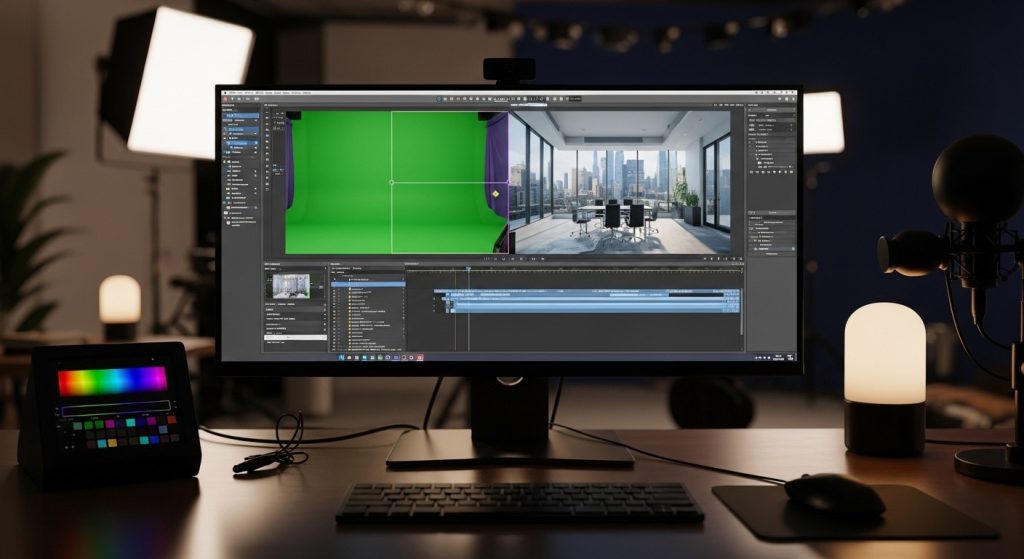
Helio can help you to decide!
The impact of your video can be made or broken by your choice between a real location and a green screen. While genuine settings offer authenticity, warmth, and emotional depth that viewers naturally engage with, green screens give you complete creative flexibility, allowing you to film anywhere from a high-tech studio to a simulated beach sunset.
Your brand story, visual tone, and production objectives will determine the best option.
Working with a professional production agency will help you make a simpler and more economical selection if you’re not sure which way to go. Regional specialists like Helio advertising and marketing agency are skilled at striking a balance between imaginative ideas and realistic logistics.
In order to determine if an on-location shot or a studio setup with virtual production will best convey your tale, they may evaluate your screenplay, audience, and budget. Working with a seasoned firm guarantees that you choose the setting that best conveys your message, rather than merely a location to shoot.
Bottom-line
You are not restricted by geography; feel free to select an unusual place for filming. Additionally, you won’t have to worry about how much it would cost or how far you would have to travel from home to construct any background for your scenes, though this would depend on whether the place is reachable by aircraft.
It takes significant consideration to strike a balance between the potential of green screen and the realism of on-location filming. To choose the best course of action, take into account your creative objectives, the skills of your team, and the resources at your disposal. Consider how each approach will affect your schedule and post-production process. Keep in mind that a hybrid strategy frequently combines the greatest aspects of both approaches.
FAQ
What are the pros of filming in a green studio?
You may shoot anywhere, at any time, and produce images that would be too costly or impractical in real life, thanks to green screen filming's complete creative flexibility. It's ideal for experimenting with various backdrops, adding visual effects, and keeping lighting consistent. Additionally, it allows for several configurations in a controlled studio setting and reduces travel expenses.
What are the cons of filming in a green studio?
Realism is the largest obstacle. The finished video may appear fake if there are issues with lighting, camera angles, or color matching. Additionally, it might delay your eَََََََََََditing schedule and necessitate expert post-production. Furthermore, performers may find it difficult to play organically in a vacant studio, which might compromise their emotional authenticity.
When is it preferable to shoot on location?
When your story depends on authenticity, emotion, and sensory detail, such as in culinary brands, lifestyle scenes, documentaries, and vacation advertisements, real places perform best. The richness, depth, and ambience that real locations naturally offer help the audience feel a true connection to your message.
Does green screen lower the cost of production?
Not all the time. Travel and permit expenditures are reduced, although color correction, VFX, and compositing may increase post-production costs. Green screen may be more expensive for short projects without sophisticated editing tools, but it is more economical for multi-scene shooting in one location.
Is it possible to set up a green screen at home?
Yes, if the background is clear, the lighting is appropriate, and the camera is positioned steadily. Make sure the performers' attire contrasts with the background and use uniform, gentle lighting on the screen. However, a studio setup or production agency is advised for outcomes of a professional quality.

